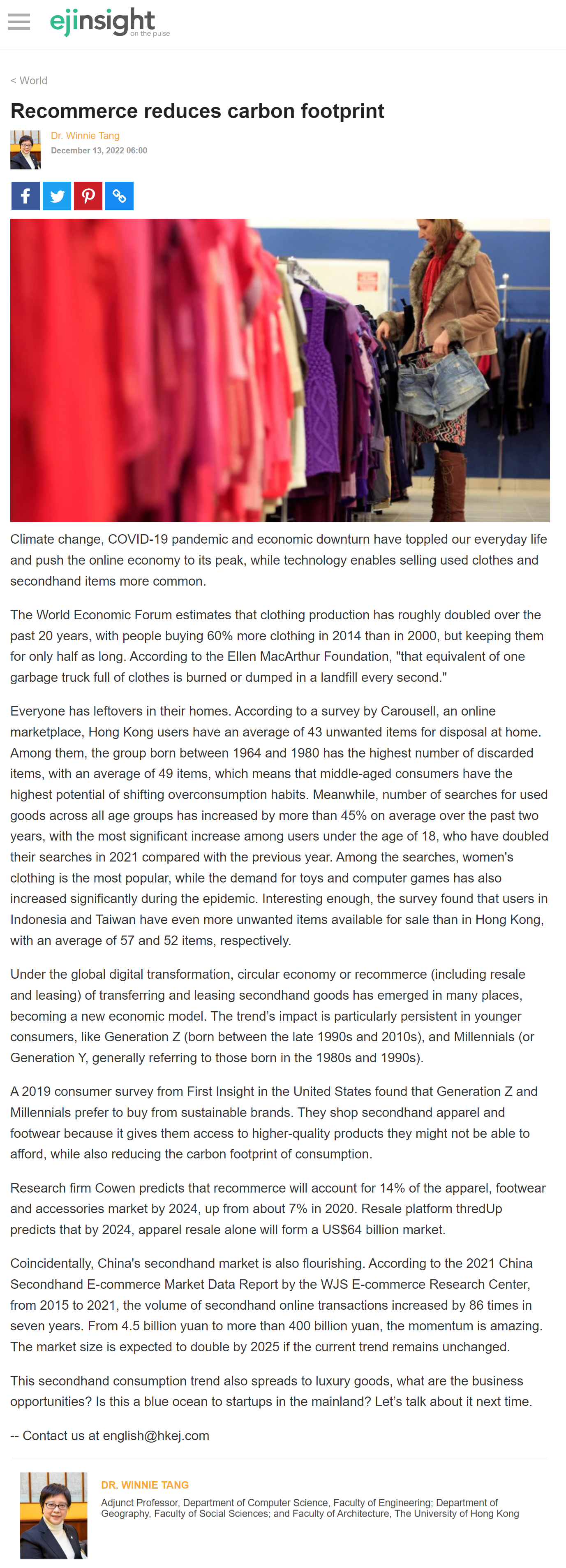網上版請按此

Recommerce reduces carbon footprint
Research firm Cowen predicts that recommerce will account for 14% of the apparel, footwear and accessories market by 2024, up from about 7% in 2020. Climate change, COVID-19 pandemic and economic downturn have toppled our everyday life and push the online economy to its peak, while technology enables selling used clothes and secondhand items more common.
The World Economic Forum estimates that clothing production has roughly doubled over the past 20 years, with people buying 60% more clothing in 2014 than in 2000, but keeping them for only half as long. According to the Ellen MacArthur Foundation, "that equivalent of one garbage truck full of clothes is burned or dumped in a landfill every second."
Everyone has leftovers in their homes. According to a survey by Carousell, an online marketplace, Hong Kong users have an average of 43 unwanted items for disposal at home. Among them, the group born between 1964 and 1980 has the highest number of discarded items, with an average of 49 items, which means that middle-aged consumers have the highest potential of shifting overconsumption habits. Meanwhile, number of searches for used goods across all age groups has increased by more than 45% on average over the past two years, with the most significant increase among users under the age of 18, who have doubled their searches in 2021 compared with the previous year. Among the searches, women's clothing is the most popular, while the demand for toys and computer games has also increased significantly during the epidemic. Interesting enough, the survey found that users in Indonesia and Taiwan have even more unwanted items available for sale than in Hong Kong, with an average of 57 and 52 items, respectively.
Under the global digital transformation, circular economy or recommerce (including resale and leasing) of transferring and leasing secondhand goods has emerged in many places, becoming a new economic model. The trend’s impact is particularly persistent in younger consumers, like Generation Z (born between the late 1990s and 2010s), and Millennials (or Generation Y, generally referring to those born in the 1980s and 1990s).
A 2019 consumer survey from First Insight in the United States found that Generation Z and Millennials prefer to buy from sustainable brands. They shop secondhand apparel and footwear because it gives them access to higher-quality products they might not be able to afford, while also reducing the carbon footprint of consumption.
Research firm Cowen predicts that recommerce will account for 14% of the apparel, footwear and accessories market by 2024, up from about 7% in 2020. Resale platform thredUp predicts that by 2024, apparel resale alone will form a US$64 billion market.
Coincidentally, China's secondhand market is also flourishing. According to the 2021 China Secondhand E-commerce Market Data Report by the WJS E-commerce Research Center, from 2015 to 2021, the volume of secondhand online transactions increased by 86 times in seven years. From 4.5 billion yuan to more than 400 billion yuan, the momentum is amazing. The market size is expected to double by 2025 if the current trend remains unchanged.
This secondhand consumption trend also spreads to luxury goods, what are the business opportunities? Is this a blue ocean to startups in the mainland? Let’s talk about it next time.
Dr. Winnie Tang
Adjunct Professor, Department of Computer Science, Faculty of Engineering; Department of Geography, Faculty of Social Sciences; and Faculty of Architecture, The University of Hong Kong